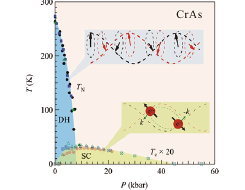Evolution of Magnetic Double Helix and Quantum Criticality Near a Dome of Superconductivity in CrAs
Uwatoko Group
The study of unconventional superconductivity (SC) is one of the most vigorous research fields in condensed matter physics. Although the underlying mechanisms for the unconventional SC in cuprate, iron-based, and heavy-fermion superconductors remains elusive, extensive investigations over the last decades have evidenced quantum criticality as a candidate mechanism for these diverse classes of superconductors. The phase diagrams of these materials often feature a superconducting dome situated adjacent to a magnetically ordered state, with the optimal superconducting transition temperature (Tc) located near a quantum critical point. The close proximity of SC to magnetic order makes it important to elucidate the nature of magnetism.

Fig. 1. Pressure dependencies of the double helical (DH) magnetic transition temperature TN and the superconducting (SC) transition temperature Tc for CrAs. Schematic views of the DH structure and Cooper pairing are illustrated in the figure.
Recently, we found CrAs as the first superconductor among Cr-based compounds. The transport measurements indicated that the development of SC is accompanied by the suppression of double-helical magnetic order that is coupled with a first-order isostructural transition at ambient pressure. These observations make CrAs an ideal platform for in-depth studies on how the coupled structural and helimagnetic orders are tuned to the critical point and how the magnetism is coupled to the unconventional SC developed nearby. In combinations of elastic and inelastic neutron scattering, resistivity, and specific-heat measurements on undoped CrAs and P-doped CrAs1-xPx single crystals and powders, we have studied systematically the evolutions of static helical order and dynamic spin correlations as well as the electronic properties of CrAs when its coupled structural/helical order is suppressed by either external pressure or the chemical substitutions.
Neutron diffraction on the single-crystal CrAs under hydrostatic pressure (P) shows that the combined order is suppressed at Pc ≈ 10 kbar, near which bulk superconductivity develops with a maximal transition temperature Tc ≈ 2 K. We further show that the coupled order is also completely suppressed by phosphorus doping in CrAs1-xPx at a critical xc ≈ 0.05, above which inelastic neutron scattering evidenced persistent antiferromagnetic correlations, providing a possible link between magnetism and superconductivity. In line with the presence of antiferromagnetic fluctuations near Pc (xc), the A coefficient of the quadratic temperature dependence of resistivity exhibits a dramatic enhancement as P (x) approaches Pc (xc), around which r(T) has a non-Fermi-liquid form. Accordingly, the electronic specific-heat coefficient of CrAs1-xPx peaks out around xc. These properties provide clear evidences for quantum criticality, which we interpret as originating from a nearly second-order helimagnetic quantum phase transition that is concomitant with a first-order structural transition.
We propose that these results can be understood in terms of a proximity to a magnetic quantum critical point tuned by the degree of the incipient localization of the Cr-3d states, possibly via an orbital-selective Mottness mechanism. Our findings in CrAs highlight the distinct characteristics of quantum criticality in bad metals, thereby bringing out new insights into the physics of unconventional SC such as occurring in the high-Tc iron pnictides.
References
- [1] W. Wu, J.-G. Cheng, K. Matsubayashi, P. P. Kong, F. K. Lin, C. Q. Jin, N. L. Wang, Y. Uwatoko, and J. L. Luo, Nature Communications 5, 5508 (2014) .
- [2] M. Matsuda, F. K. Lin, R. Yu, J.-G. Cheng, W. Wu, J. P. Sun, J. H. Zhang, P. J. Sun, K. Matsubayashi, T. Miyake, T. Kato, J.-Q. Yan, M. B. Stone, Qimiao Si, J. L. Luo, and Y. Uwatoko, Phys. Rev. X 8, 031017 (2018).
